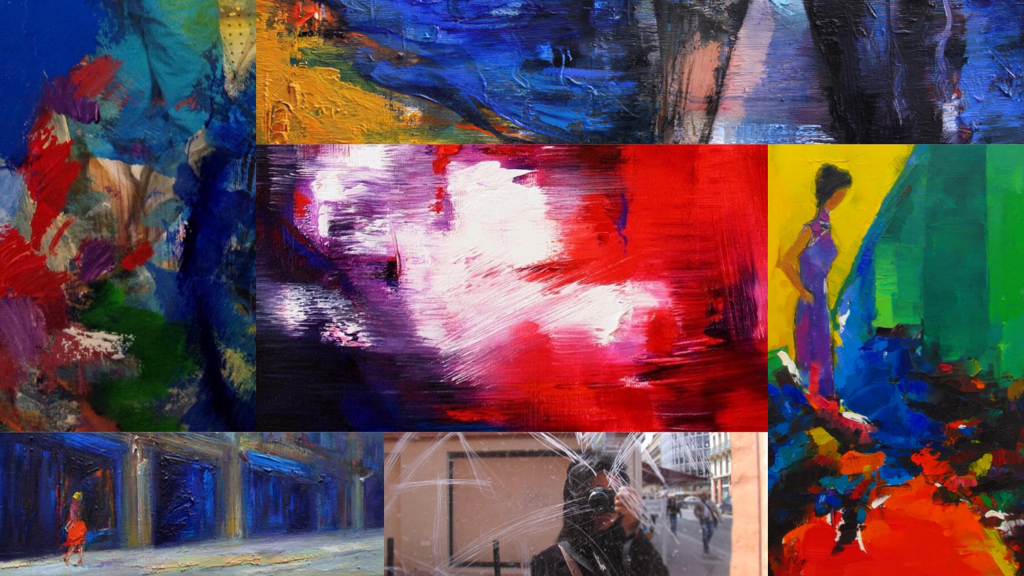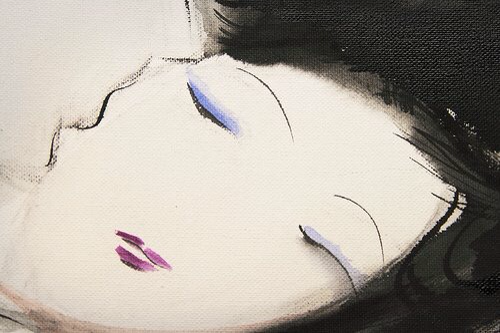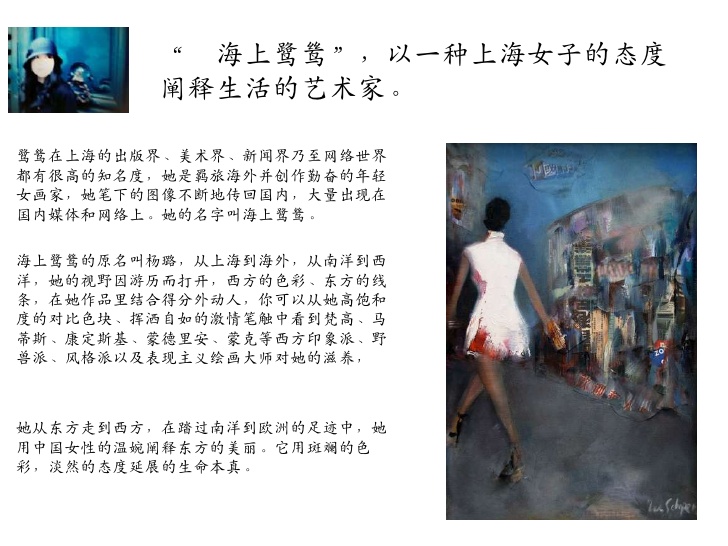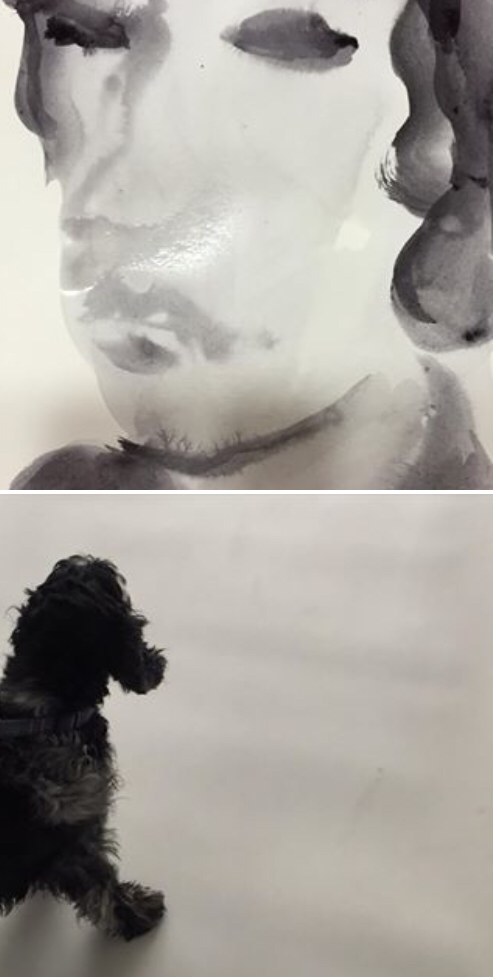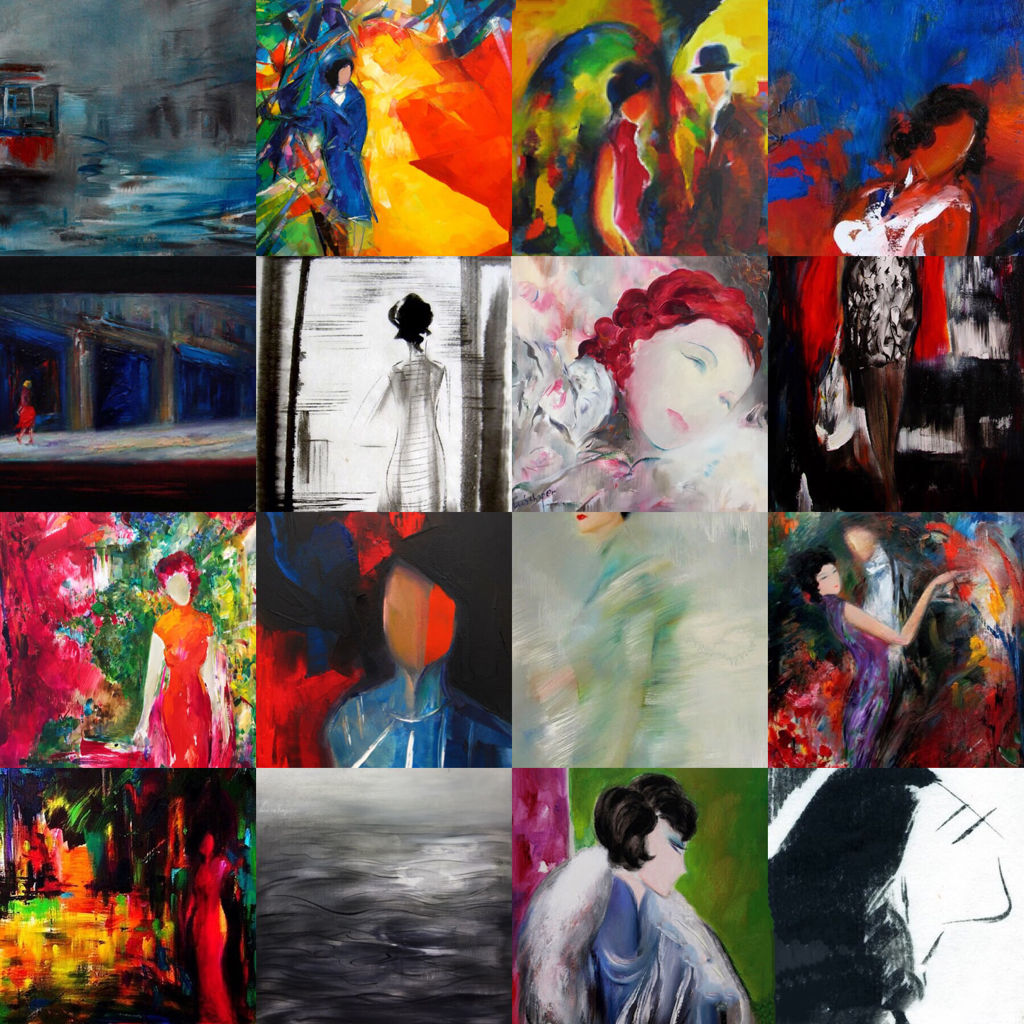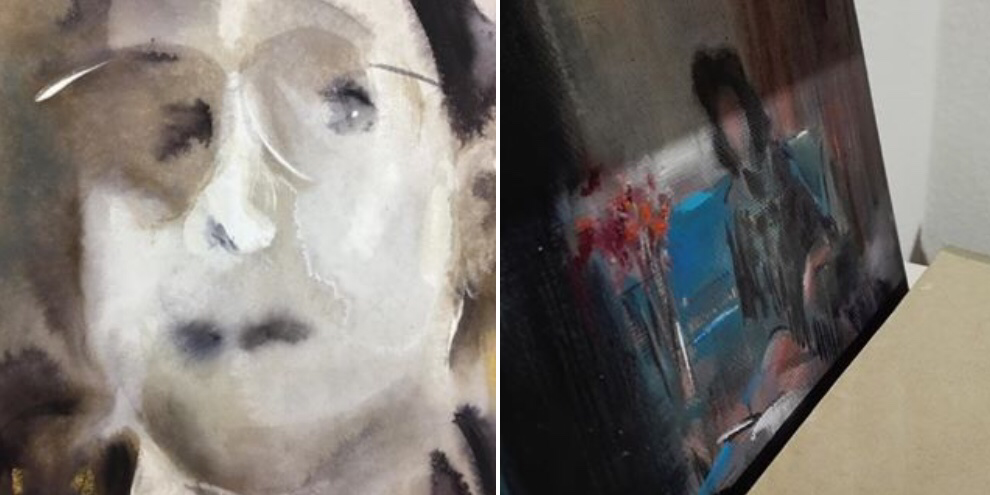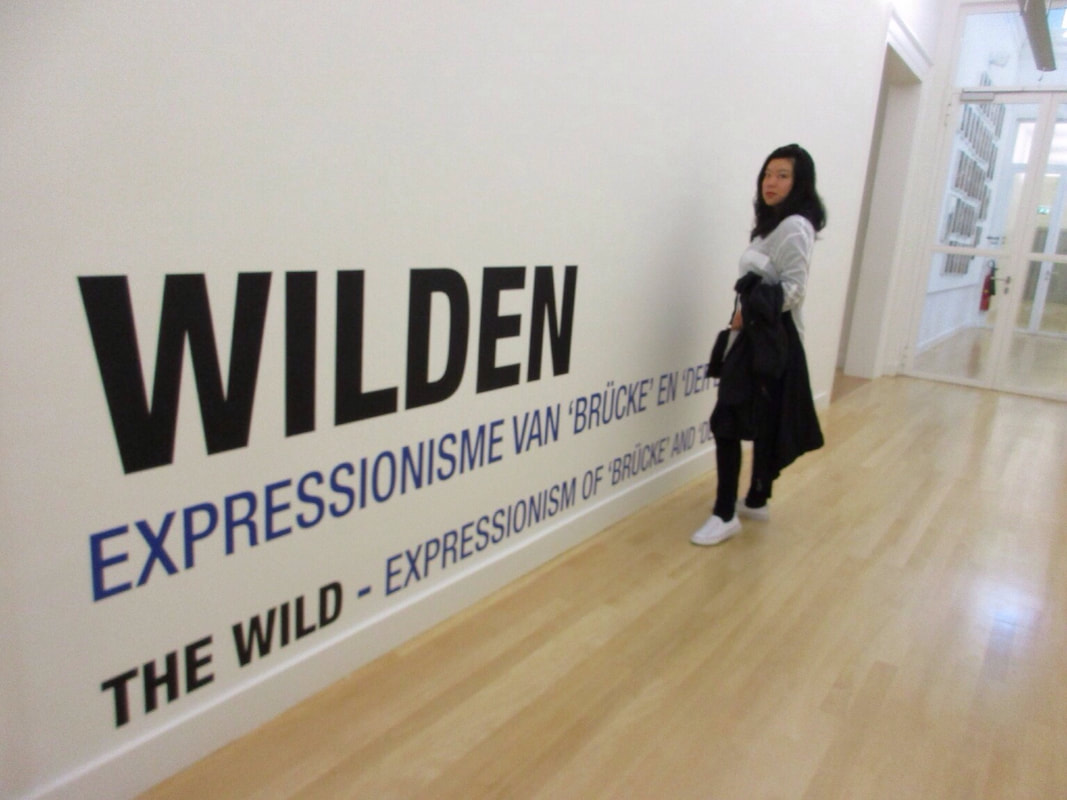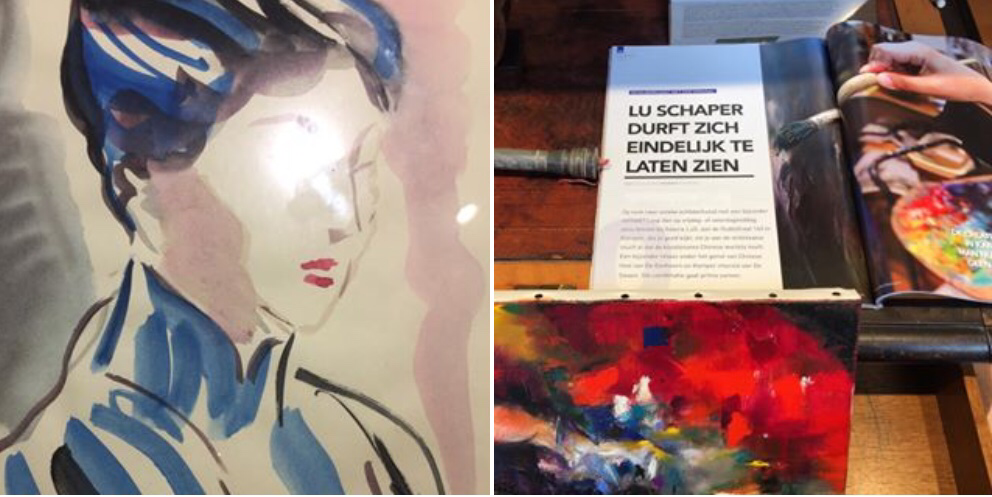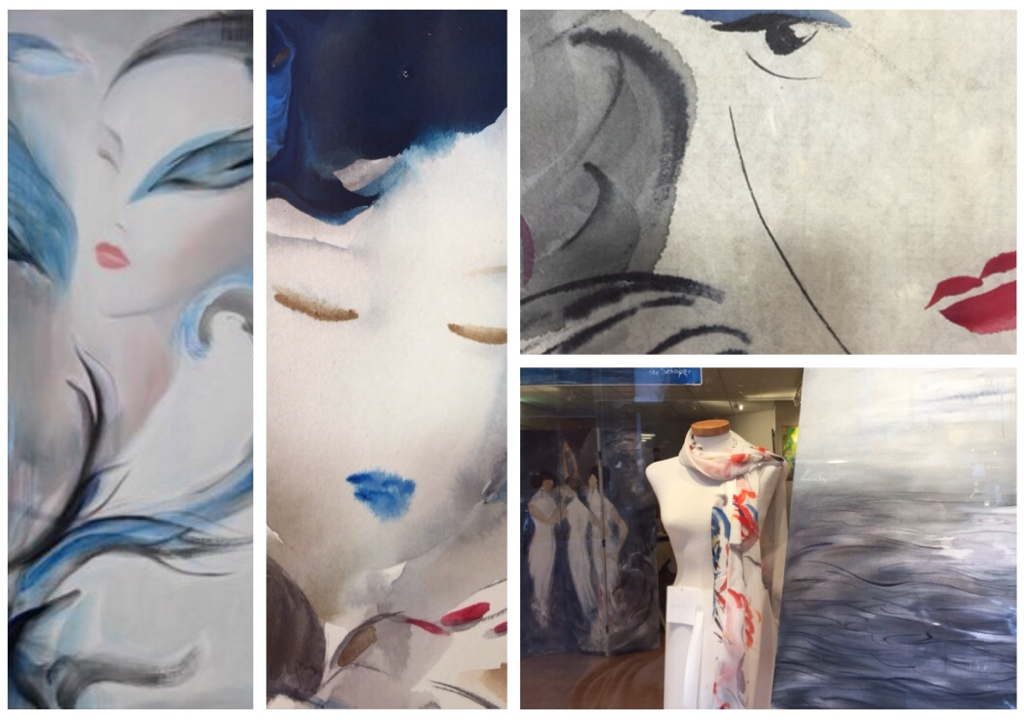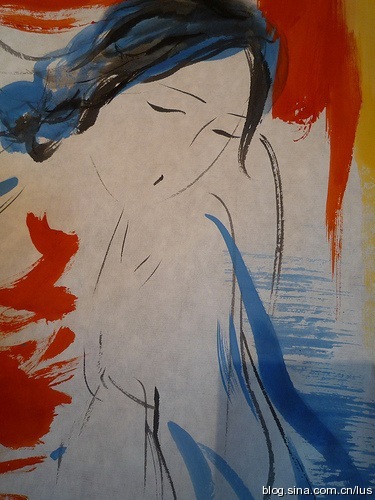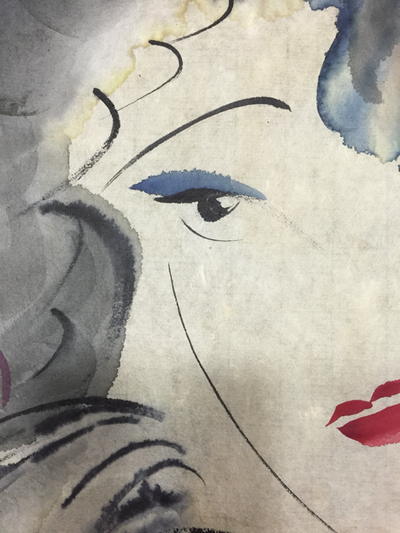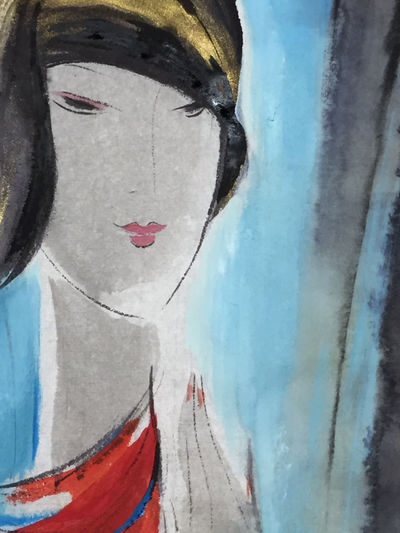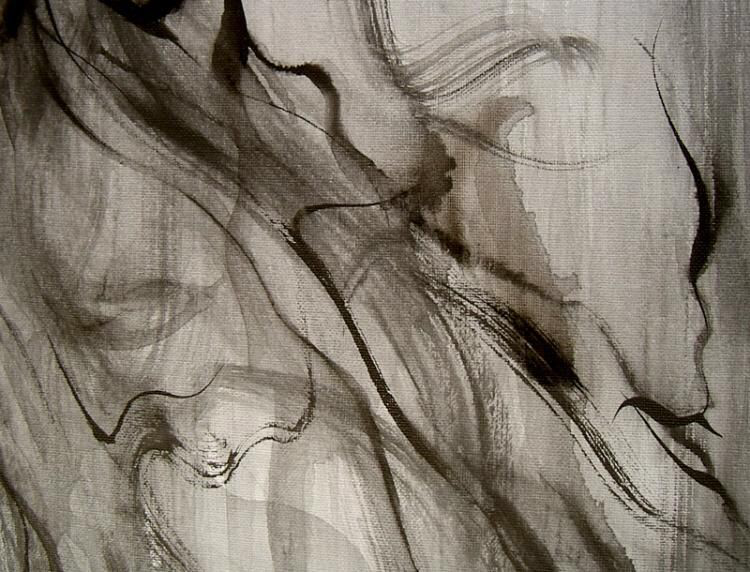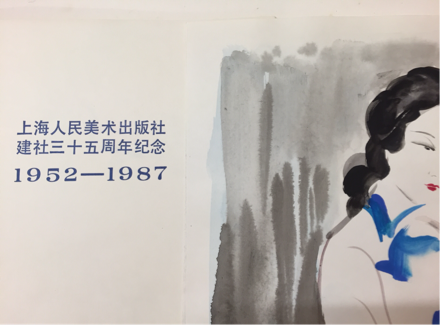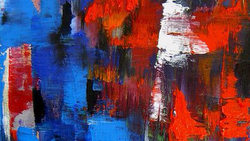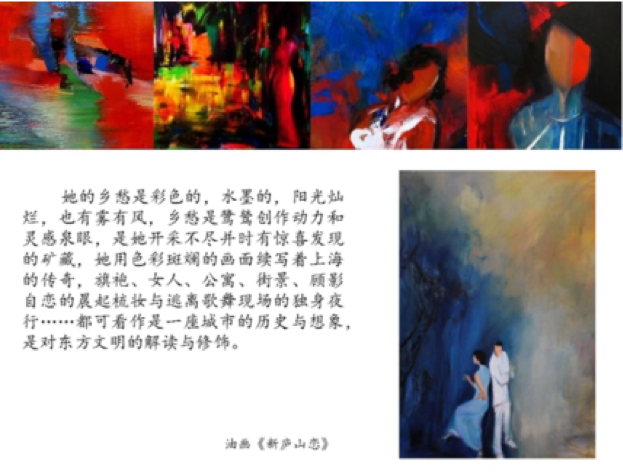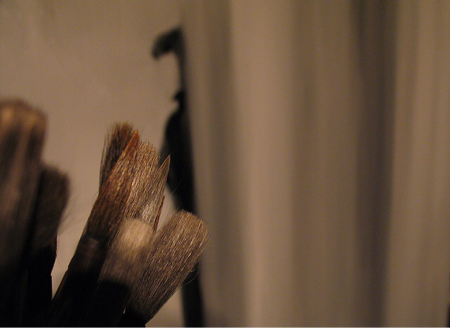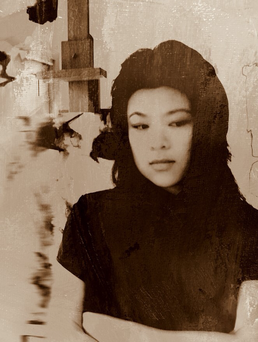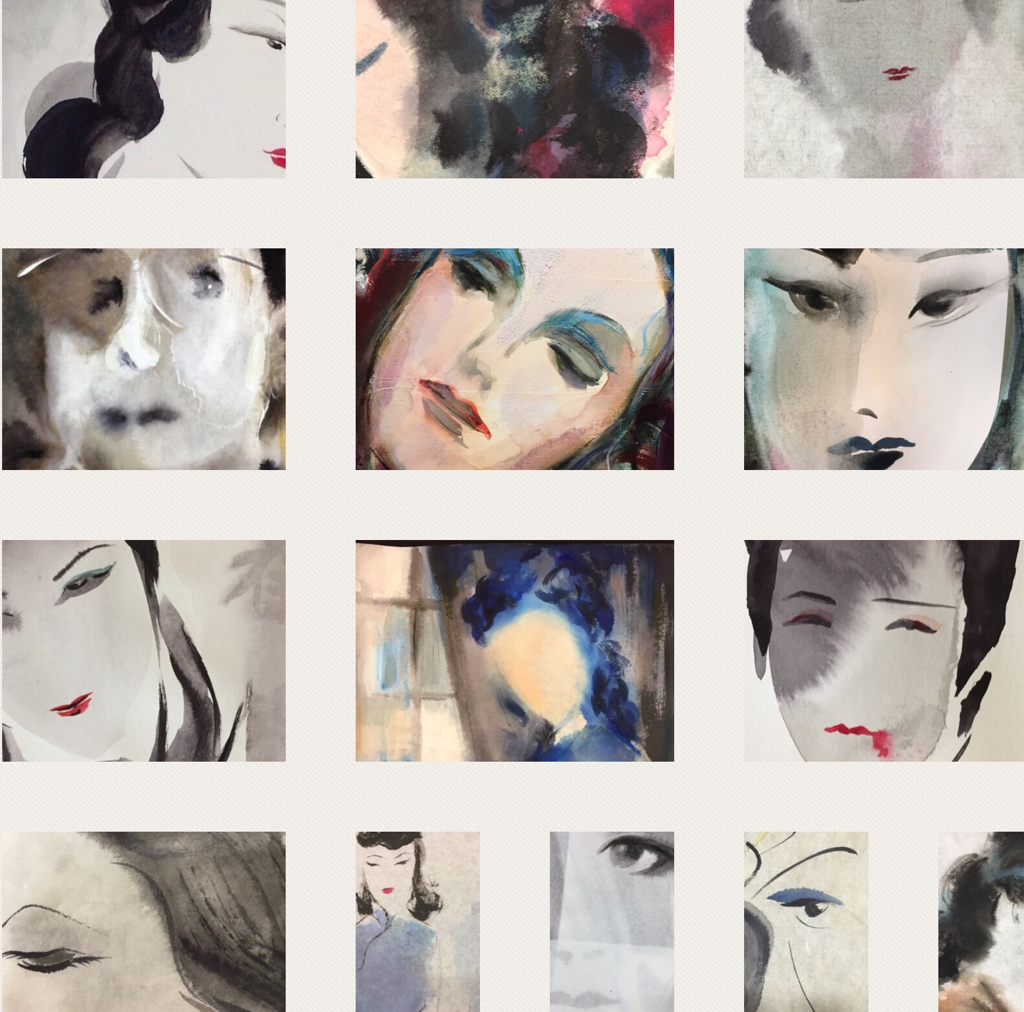|
每个画家在不同时期都会面对风格与生活的成长,不被风格捆绑,不为生活所累,舒展自己内心的感觉是可遇不可求的,但不是每个人都有这个条件与机遇,珍惜自己所拥有的。身边有太多优秀的艺术家值得我学习,艺术的魅力就是可以不断随着自己的内心成长,和旅行有点儿同样的意思。从小就在自己的精神世界里游荡,画面也是自己内心的投射,绘画无需与人合作,可以独立完成,在寻找的路上……一步步将情绪转化为艺术,彼此共情。
我画的上海是我心中的上海,画面中的人物有些来自亲人和朋友,有些来自记忆。 在离开故乡上海的二十多年中,我在独特的文化背景和艺术生涯下创作了一系列以上海为主题的绘画作品; 往返在上海和欧洲之间的生活给了我无限的灵感和创作空间,无论是用画布、水墨、影像或数字绘画,都充满了探索的乐趣。 在《画说》中,张大千作过不少中西绘画的论述: 作画根本无中西之分。 中西绘画,理论上是相通的。毕加索曾亲口告诉我,他自己就受到中国画的影响而有所变化。近代我国画家也在吸收西画的优点。所以我说中国画与西画,应无多大的距离和分别。 一个人若能将西画的长处溶化到中国画里来,要看起来完全是中国画的神韵,不留丝毫西画的外貌,这定要绝顶聪明的天才同非常勤苦的用功,才能有此成就,稍一不慎,便走火入魔了。 |
离开上海才会想念上海。"海上鹭鸶" 是中国古代文学作品《离骚》中的一个典故,它是指鹭鸟在海上展翅翱翔的情景,象征着人们不畏艰险,勇往直前的精神。这个典故在中国文化中有着很深的意义,因此也经常被用于绘画创作。现代的"海上鹭鸶"画作也有着许多精彩的创作,不仅传承了传统的绘画技法和风格,还融合了现代艺术的元素和表现方式,让人们对于这一文化典故有了更加新颖和多样化的认识和理解。
|
|
创作时是昏沉沉的整体浸入,对世间的一切都要远离,这个状态很接近😄 创作本身就是必须自我隔离的,已经是常年的习惯了,只是在这里也必须照料到具体生活,上海只管一心画画,其他都有人做了,有得必有失,也可以自由创作,只求不要自我枷锁,被技法捆绑,我们以前的训练实在太严了。画图最怕豁勿开,但又不能“野嚯嚯” 长期野了外头呃上海宁多多少少回归些了“本真” ,要“美”容易,要“丑”难,拍照和画画一样的道理。
|
前不久两张大画被本地买家收藏,这两张画历经多年修正与变动,亲手抹掉自己的心血,画画时常常经历这种“痛苦”……这种变动很难说是好是坏,特别纠结,奔走在不同的国家,常为画面中的人物牵动,如今终于安安份份与伊人客厅卧室作伴,与她同样未曾谋面,许多作品都是自己不在场的情况下被领走,无需饭局与蜜语,艺术就应这样爽快利落,艺术家不应为艺术之外的应酬所累。欧洲人买画只从听自己内心,最多也只是征求一下伴侣意见,如果空间是彼此共有的话。
|
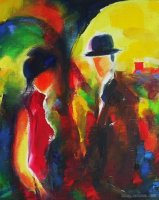
SHANGHAI EXPRESSIONISM: THE ARTIST'S VIEW
From the time when I was a young child in Shanghai, I have always had a lot of contact with art. Most people who visited our home were artists, At home I also had a lot of art materials and art books. At that time, only the papers I was using for my sketches were my real friends. I poured all my feelings onto the paper, rather than having contact with other children of my age. At the age of ten, my art proficiency got me selected from numerous candidates for the fine art section of the renowned Shanghai City Youth Palace. The time I spent there was the happiest time of my childhood. My class mates and fellow art students treated me with respect, unlike my time at primary school. I started wondering why there could be such a different world in the same city. My teacher continuously encouraged me, both for my art and for my personality, and may never have realised how important that was for me.
A few years later, I met the famous Chinese artist Professor Chen, He told me that if I would choose art for a career, I should be prepared to endure suffering the rest of my life. His own appearance, thin and short sighted, clearly supported his words. Then he asked me whether I was still planning to take that road. I thought about it, considering how bad my mathematics was - what choice did I have? I could not answer him at that moment, but in my heart I knew I would take the art path. Later, after I had already entered the Art University of Shanghai, Professor Chen looked once more at my work, and proposed that nature would be my best art teacher. Unfortunately, living in a 15 million people city without any nature made that somewhat difficult. So he gave me a list of masters to study, including Matisse, Cezanne, van Gogh, Monet, but also Chinese masters. I selected Lin Fong Mian, the teacher of grandmaster Zao Wou-Ki, as my main source of inspiration. His style and personality had a big impact on me, and it was a major contributor to me learning the art of coloured Chinese ink, which was not taught at the Shanghai University. At University, I spent all my time outside art classes in the library, still finding it difficult to make friends with people of my own age. My teacher Zhao took an interest in my paintings, but told me that Lin was a different generation, with different background and different problems - as a young student, I should try to find my own way and express my own feelings. I was happy that finally someone suggested that I should take my own path, and appreciate myself rather than following masters. Unfortunately, at that age I was not in control of my life and still had to listen to other people about what I was allowed to paint.
I decided to explore options outside China, and went first to Malaysia, then to Singapore. The merciless tropical sunshine in those countries made me paint indoors, with curtains closed, listening to jazz music. Often the subject of my paintings was based on Shanghai, which was still very much on my mind and in my heart. Whenever I used warm colours, I found that this was not really me, so I started to use more and more cold colours, undoubtedly also as a reaction to the hot climate.I was glad to have the opportunity to leave Singapore and move to Rouen (France), the cradle of impressionism. I finally started to explore nature in my art, in an impressionist fashion, capturing the Normandy skies on canvas. A holiday in the Provence and Tuscany proved a major turning point for me. The sunshine, strong blue skies and bright colours made me question whether impressionism, with its subtle light changes, was the way to go. It opened my eyes and my heart, and I understood the change that came over Vincent van Gogh when he settled there from the cold and grey North, and why this region had so much inspired other artists like Cezanne, Picasso and Matisse. One single experience in particular made a strong impression on me: in a small Provence town, I saw the mistral turn the poppy fields into waves of colour, and I decided that I wanted to capture effects like this in my art. My fascination with cold colours was finally gone that moment. Strong warm and bright colours would be my future, and I was very excited about it. When I returned home, I immediately started to turn these new feelings into a new series of paintings.
Half a year later, another holiday brought all the pieces together. I had always admired the German expressionist masters that I knew from books, like Kandisnky, Macke and Marc, but seeing so many of the original masterpieces collected in the Munich musea had an immense effect on me. I had the feeling like a hunter must have when he finally catches the deer he has been chasing so long. This was it. This was the art style I had been looking for, this tought me so much about my own feelings. Only this style would allow me to fully express all my emotions. I had finally come to the point where I decided that it was not important what someone else thought about my art, only my own opinion counted. Not only in art, but in life as well. A clear break from the traditional Chinese way of thinking, where other people's opinions of you are paramount.
As a Shanghainese in Europe, it was natural and part of myself, that my art would continue to have Shanghainese themes in it. Especially as the increased distance in time and space from the town where I grew up made me reappreciate the beauty of Shanghai. When I lived there as a child, one of my strongest impressions was walking through the elegant French area, looking at the European style buildings from the thirties, and wondering about the stories behind them. When I left Shanghai, the city was rapidly changing into just another modern metropole, and I thought my feelings for this city would diminish quickly. However, from the distance of Europe I found out that you can never forget the feelings for your home town, be they good or bad. I have the feeling I only now fully understand Shanghai, and that it will always be alive in me. In France, I am finally able to turn these strong inner feelings about Shanghai into my art. In the past, Shanghai was called the Paris of the Orient. For Paris, the important word here is Orient, for Shanghai the important word here is Paris. Both elegant cities, fashion capitals, with high lifestyle, always like being on a stage. Both cities in which the people have to face the real life problems, still have their dreams, but have the typical large-city mentality of keeping a distance. Both cities in which people grow up in a city culture. They see pictures of the sea long before they actually see the sea, they read about love before experiencing love. The real experience always follows the imagined one. In this sense, there is very little difference between East and West. have had the chance to contact people from different countries, different races and different backgrounds. This has considerably broadened my mind. I no longer assume that everybody would have to be the same as me, do the same things the same way. I can now focus on anything that interests me, I can finally choose for myself what I like and what I don't like, I love this freedom. This also makes me understand myself more. Every new travel destination is like a new chapter in the book of my life, I want to see everything with my Asian eyes and answer the questions they pose.
绘画是自己从小就学的,说是选择也好,三岁的小孩也没啥选择, 幸好这是我爱的,符合了我的天性,后天由于时代的惠顾,也学到了很多,那时候不象现在的人们有着这么多自由选择和纷杂的讯息,所以很专心,小时候我每天把心中的疑问记录在本子上,见到了画家们就当面请教,无论对方是哪一路高手,我问的都是素描基本功的问题,画家们对我这个小学生的耐心与教导都令我难忘,很和蔼,回答也很细致, 因为整天埋头画画,所以也就没有同龄的朋友,连小孩子之间最简单的游戏也不会做,围绕在身边的都是大人,在时代洪流中无奈的的大人,过早地品尝着离别的苦楚, 那时候纯艺术的地位还是很高的,人海绵般吸取养料的大好时段也就在那些年,然后,会巩固,发展,变化,甚至抛弃,剩下的还在画画的,那就真的是喜欢画画的,现在从表面上看绘画的天地已经大大缩小,数码影像的出现,使得传统绘画的意义进一步削弱,不过也因为摄影的广泛运用,使得绘画的语言更为纯正和突显个人的情趣,我画的上海是我心中的上海,所有的画面中都是上海女子,有些来自我的记忆,有些来自一种熟悉情境的再现,有些是我个人情感的寄托,她们面目模糊,却都着东方旗袍,每个人因为不同的经历和个性,会对画面有着各自的理解和反映,我不会限制观众的思维。
上海,Shanghai 这个词在西方是一种亚洲的象征,因此很多与亚洲物品有关的商号,也取名Shanghai ,无论主人是否与上海有关,是否会中文,乃至上海话。说起来令人意外,实际上我十多年前在上海的时候,在很长的一段时间内,我非常抗拒讲上海话,当时觉得很多细腻优雅的感觉无法用上海话来表达,认为中文里面最美的就是以北京话为基础的华语,后来我从上海到南洋,在一些偶然的机会里,才发现以前的上海人和上海话完全不是我长大后接触的那个样子,那些保留下来的老上海人的生活方式是如此从容,得体,温润,又有品格,想起来这些疑问实际上是我很小的时候就埋下的种子,却一直没有机会发芽,不喜欢为了市场和别人的喜好而做画,虽然那使我很容易被周围的人理解和获得赞扬,但我始终不能表达自己的内心, 从2002年抵达法国开始,我开始了艰苦又其乐无穷的探索,我不断尝试更靠近和适合自己的表现方式,发展自己最钟爱与顺畅的创作方法,能够专注在自己适合和喜欢的题材与风格上创作,是我喜欢的绘画生活,每个人因为不同的经历而造就性格,也造成生活方式的不同,在不断反省和充实自己的过程中开垦一条自己的路,艺术没有标准,我的要求就是能过自己这一关。离开故乡上海已经20年了,时空和距离让我在回想她的时候衍生出了自己画面中的人物的色彩,时光与画面一起构成的雕筑形成了上海独特的气韵与面貌,这些都让我投入与沉醉,
命运好像国画立轴,它慢慢展开,时间让每个人都以同样的速度展开自己的画卷,而我们只能回望已经盛开的图画,小心掌握用水的份量,有前面的基调,还要考虑未来的衔接,而我们也无法阻挡画面的推进,每每我们不乐之时,就多想想以往的难,这样也就平添出些许快乐,若的确是一件也想不出来,那就与我那样,躲入图书馆,别小看可精神力量,它既伟大,又无能,这就是艺术,我把艺术视为宗教,童年的暑假自己被锁在出版社的书库里,那是一把快乐的小锁,还能看到外面的光,我宁愿呆在一个小小的安全空间里,哪怕书里的妖怪会飞出来,他们最终还是要回到瓶子里去,因为书里有正义的宝剑,很多时候,画面就像一匹野马,我要做的就是如何掌握缰绳,有时候,可以走彼岸,有时候却被马掀翻在地上,满身泥浆。
希望通过每一次的失败,学到更多的经验,更多时候,还是冥冥之中的安排。
From the time when I was a young child in Shanghai, I have always had a lot of contact with art. Most people who visited our home were artists, At home I also had a lot of art materials and art books. At that time, only the papers I was using for my sketches were my real friends. I poured all my feelings onto the paper, rather than having contact with other children of my age. At the age of ten, my art proficiency got me selected from numerous candidates for the fine art section of the renowned Shanghai City Youth Palace. The time I spent there was the happiest time of my childhood. My class mates and fellow art students treated me with respect, unlike my time at primary school. I started wondering why there could be such a different world in the same city. My teacher continuously encouraged me, both for my art and for my personality, and may never have realised how important that was for me.
A few years later, I met the famous Chinese artist Professor Chen, He told me that if I would choose art for a career, I should be prepared to endure suffering the rest of my life. His own appearance, thin and short sighted, clearly supported his words. Then he asked me whether I was still planning to take that road. I thought about it, considering how bad my mathematics was - what choice did I have? I could not answer him at that moment, but in my heart I knew I would take the art path. Later, after I had already entered the Art University of Shanghai, Professor Chen looked once more at my work, and proposed that nature would be my best art teacher. Unfortunately, living in a 15 million people city without any nature made that somewhat difficult. So he gave me a list of masters to study, including Matisse, Cezanne, van Gogh, Monet, but also Chinese masters. I selected Lin Fong Mian, the teacher of grandmaster Zao Wou-Ki, as my main source of inspiration. His style and personality had a big impact on me, and it was a major contributor to me learning the art of coloured Chinese ink, which was not taught at the Shanghai University. At University, I spent all my time outside art classes in the library, still finding it difficult to make friends with people of my own age. My teacher Zhao took an interest in my paintings, but told me that Lin was a different generation, with different background and different problems - as a young student, I should try to find my own way and express my own feelings. I was happy that finally someone suggested that I should take my own path, and appreciate myself rather than following masters. Unfortunately, at that age I was not in control of my life and still had to listen to other people about what I was allowed to paint.
I decided to explore options outside China, and went first to Malaysia, then to Singapore. The merciless tropical sunshine in those countries made me paint indoors, with curtains closed, listening to jazz music. Often the subject of my paintings was based on Shanghai, which was still very much on my mind and in my heart. Whenever I used warm colours, I found that this was not really me, so I started to use more and more cold colours, undoubtedly also as a reaction to the hot climate.I was glad to have the opportunity to leave Singapore and move to Rouen (France), the cradle of impressionism. I finally started to explore nature in my art, in an impressionist fashion, capturing the Normandy skies on canvas. A holiday in the Provence and Tuscany proved a major turning point for me. The sunshine, strong blue skies and bright colours made me question whether impressionism, with its subtle light changes, was the way to go. It opened my eyes and my heart, and I understood the change that came over Vincent van Gogh when he settled there from the cold and grey North, and why this region had so much inspired other artists like Cezanne, Picasso and Matisse. One single experience in particular made a strong impression on me: in a small Provence town, I saw the mistral turn the poppy fields into waves of colour, and I decided that I wanted to capture effects like this in my art. My fascination with cold colours was finally gone that moment. Strong warm and bright colours would be my future, and I was very excited about it. When I returned home, I immediately started to turn these new feelings into a new series of paintings.
Half a year later, another holiday brought all the pieces together. I had always admired the German expressionist masters that I knew from books, like Kandisnky, Macke and Marc, but seeing so many of the original masterpieces collected in the Munich musea had an immense effect on me. I had the feeling like a hunter must have when he finally catches the deer he has been chasing so long. This was it. This was the art style I had been looking for, this tought me so much about my own feelings. Only this style would allow me to fully express all my emotions. I had finally come to the point where I decided that it was not important what someone else thought about my art, only my own opinion counted. Not only in art, but in life as well. A clear break from the traditional Chinese way of thinking, where other people's opinions of you are paramount.
As a Shanghainese in Europe, it was natural and part of myself, that my art would continue to have Shanghainese themes in it. Especially as the increased distance in time and space from the town where I grew up made me reappreciate the beauty of Shanghai. When I lived there as a child, one of my strongest impressions was walking through the elegant French area, looking at the European style buildings from the thirties, and wondering about the stories behind them. When I left Shanghai, the city was rapidly changing into just another modern metropole, and I thought my feelings for this city would diminish quickly. However, from the distance of Europe I found out that you can never forget the feelings for your home town, be they good or bad. I have the feeling I only now fully understand Shanghai, and that it will always be alive in me. In France, I am finally able to turn these strong inner feelings about Shanghai into my art. In the past, Shanghai was called the Paris of the Orient. For Paris, the important word here is Orient, for Shanghai the important word here is Paris. Both elegant cities, fashion capitals, with high lifestyle, always like being on a stage. Both cities in which the people have to face the real life problems, still have their dreams, but have the typical large-city mentality of keeping a distance. Both cities in which people grow up in a city culture. They see pictures of the sea long before they actually see the sea, they read about love before experiencing love. The real experience always follows the imagined one. In this sense, there is very little difference between East and West. have had the chance to contact people from different countries, different races and different backgrounds. This has considerably broadened my mind. I no longer assume that everybody would have to be the same as me, do the same things the same way. I can now focus on anything that interests me, I can finally choose for myself what I like and what I don't like, I love this freedom. This also makes me understand myself more. Every new travel destination is like a new chapter in the book of my life, I want to see everything with my Asian eyes and answer the questions they pose.
绘画是自己从小就学的,说是选择也好,三岁的小孩也没啥选择, 幸好这是我爱的,符合了我的天性,后天由于时代的惠顾,也学到了很多,那时候不象现在的人们有着这么多自由选择和纷杂的讯息,所以很专心,小时候我每天把心中的疑问记录在本子上,见到了画家们就当面请教,无论对方是哪一路高手,我问的都是素描基本功的问题,画家们对我这个小学生的耐心与教导都令我难忘,很和蔼,回答也很细致, 因为整天埋头画画,所以也就没有同龄的朋友,连小孩子之间最简单的游戏也不会做,围绕在身边的都是大人,在时代洪流中无奈的的大人,过早地品尝着离别的苦楚, 那时候纯艺术的地位还是很高的,人海绵般吸取养料的大好时段也就在那些年,然后,会巩固,发展,变化,甚至抛弃,剩下的还在画画的,那就真的是喜欢画画的,现在从表面上看绘画的天地已经大大缩小,数码影像的出现,使得传统绘画的意义进一步削弱,不过也因为摄影的广泛运用,使得绘画的语言更为纯正和突显个人的情趣,我画的上海是我心中的上海,所有的画面中都是上海女子,有些来自我的记忆,有些来自一种熟悉情境的再现,有些是我个人情感的寄托,她们面目模糊,却都着东方旗袍,每个人因为不同的经历和个性,会对画面有着各自的理解和反映,我不会限制观众的思维。
上海,Shanghai 这个词在西方是一种亚洲的象征,因此很多与亚洲物品有关的商号,也取名Shanghai ,无论主人是否与上海有关,是否会中文,乃至上海话。说起来令人意外,实际上我十多年前在上海的时候,在很长的一段时间内,我非常抗拒讲上海话,当时觉得很多细腻优雅的感觉无法用上海话来表达,认为中文里面最美的就是以北京话为基础的华语,后来我从上海到南洋,在一些偶然的机会里,才发现以前的上海人和上海话完全不是我长大后接触的那个样子,那些保留下来的老上海人的生活方式是如此从容,得体,温润,又有品格,想起来这些疑问实际上是我很小的时候就埋下的种子,却一直没有机会发芽,不喜欢为了市场和别人的喜好而做画,虽然那使我很容易被周围的人理解和获得赞扬,但我始终不能表达自己的内心, 从2002年抵达法国开始,我开始了艰苦又其乐无穷的探索,我不断尝试更靠近和适合自己的表现方式,发展自己最钟爱与顺畅的创作方法,能够专注在自己适合和喜欢的题材与风格上创作,是我喜欢的绘画生活,每个人因为不同的经历而造就性格,也造成生活方式的不同,在不断反省和充实自己的过程中开垦一条自己的路,艺术没有标准,我的要求就是能过自己这一关。离开故乡上海已经20年了,时空和距离让我在回想她的时候衍生出了自己画面中的人物的色彩,时光与画面一起构成的雕筑形成了上海独特的气韵与面貌,这些都让我投入与沉醉,
命运好像国画立轴,它慢慢展开,时间让每个人都以同样的速度展开自己的画卷,而我们只能回望已经盛开的图画,小心掌握用水的份量,有前面的基调,还要考虑未来的衔接,而我们也无法阻挡画面的推进,每每我们不乐之时,就多想想以往的难,这样也就平添出些许快乐,若的确是一件也想不出来,那就与我那样,躲入图书馆,别小看可精神力量,它既伟大,又无能,这就是艺术,我把艺术视为宗教,童年的暑假自己被锁在出版社的书库里,那是一把快乐的小锁,还能看到外面的光,我宁愿呆在一个小小的安全空间里,哪怕书里的妖怪会飞出来,他们最终还是要回到瓶子里去,因为书里有正义的宝剑,很多时候,画面就像一匹野马,我要做的就是如何掌握缰绳,有时候,可以走彼岸,有时候却被马掀翻在地上,满身泥浆。
希望通过每一次的失败,学到更多的经验,更多时候,还是冥冥之中的安排。
|
深夜跳出一封陌生的电子邮件,一对来自英国牛津的夫妇正在楼下画廊橱窗驻足,大雨如注中一眼相中了我刚换的油画,第二天一大早就要赶飞机回去了,先生征求太太的意见,肯定的眼神,虽然家里已经收藏了很多画,不过我想他们心中一定已经有了一个需要这幅画的地方,点亮一段回忆或展望。YQ期间画的几张纷纷飞向四方,以后应该记得每次客户把画带走后都让我知道如何安放,这些作品从心中跃到画布,展翅飞向更高更远的地方经历了多少道磨难与坎坷,最近不少朋友与客户们反应,最喜欢的是我画面中的空间与赋予观者的想象力,一幅画面的完成是和观者共同完成的,正如电影或小说的开放式结尾,我想这也是对创作者最好的呼应与肯定,今后将更专注钟情的题材创作,不负上天的期许[合十][合十]🍷🍷
|
